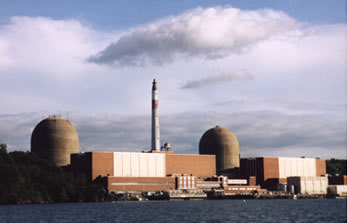Nuclear Energy's Green Glow
"Several of the nation's most prominent environmentalists have gone public with the message that nuclear power, long taboo among environmental advocates, should be reconsidered as a remedy for global warming," the New York Times' Felicity Barringer reports. And while environmentalists who support nuclear power as a supposedly "emission-free" alternative to fossil fuels are not representative of the larger movement, the buzz about them is mushrooming. "Their numbers are still small, but they represent growing cracks in what had been a virtually solid wall of opposition to nuclear power among most mainstream environmental groups," writes the Times.
Make no mistake -- nuclear power has not become any safer or cleaner. Nuclear plants still pose a huge threat to the communities in which they are located and highly radioactive spent fuel has yet to be dealt with adequately. "It's not that something new and important and good had happened with nuclear, it's that something new and important and bad has happened with climate change," Stewart Brand, a founder of the Whole Earth Catalog and a new devotee of nuclear energy, told the Times.
In fact, the only thing that the nuclear power industry has been working to clean up is its image. The first quarter issue of PR Watch, now available online, examines the industry's use of public relations to quell safety concerns and undermine grassroots efforts to shut down nuclear plants. Over the past several years, PR Watch has seen a marked increase in industry efforts to change the public's perception of nuclear power.
 Entergy's Indian Point nuclear power plant sits on New York's Hudson River just 35 miles from Midtown Manhattan.Contrary to the Times' reporting, divisions among environmental activists are nothing new. In some cases, environmentalists have become highly-paid greenwashers: former Greenpeace Canada leader Patrick Moore now consults for the mining, timber and fishery industries, and former Greenpeace UK leader Peter Melchett now works for PR giant Burson Marsteller. In other cases, differences arise in the absence of direct monetary benefit: Stewart Brand and British scientist James Lovelock are among the high-profile environmentalists to currently lend their names to support a polluting industry.
Entergy's Indian Point nuclear power plant sits on New York's Hudson River just 35 miles from Midtown Manhattan.Contrary to the Times' reporting, divisions among environmental activists are nothing new. In some cases, environmentalists have become highly-paid greenwashers: former Greenpeace Canada leader Patrick Moore now consults for the mining, timber and fishery industries, and former Greenpeace UK leader Peter Melchett now works for PR giant Burson Marsteller. In other cases, differences arise in the absence of direct monetary benefit: Stewart Brand and British scientist James Lovelock are among the high-profile environmentalists to currently lend their names to support a polluting industry.
Lovelock, a climatologist, has been on record for nearly two decades as not opposing nuclear energy as an alternative to energy created by greenhouse gas producing fuel sources. But he stirred the pro-nuclear pot in May 2004, writing in an editorial in the UK's Independent, "I am a Green and I entreat my friends in the movement to drop their wrongheaded objection to nuclear energy. ... We have no time to experiment with visionary energy sources; civilisation is in imminent danger and has to use nuclear -- the one safe, available, energy source -- now or suffer the pain soon to be inflicted by our outraged planet."
With all the positive press (even around the 25th anniversary of the Three Mile Island meltdown), the "mood in the nuclear power industry has dramatically brightened," the Christian Science Monitor's David R. Francis writes. "Both in the United States and abroad, industry officials, dare we say it, radiate optimism."
The Bush administration has also gotten in on the act of promoting nuclear power -- while, true to form, avoiding the global warming issue. "President Bush has proposed reducing oil imports by increasing the use of nuclear power, which he said in a recent speech was 'one of the most promising sources of energy.' There is a problem, though: reactors make electricity, not oil. And oil does not make much electricity," the New York Times' Matthew Wald wrote recently. "Could a few dozen more reactors, in addition to the 103 running now, cut into oil's share of the energy market? 'Indirectly, but very indirectly,' said Lawrence J. Goldstein, president of the Petroleum Industry Research Foundation, a nonprofit group that studies the economics of oil. People who think nuclear power is a way to reduce oil imports are 'confusing several issues,' he said."
But the people "confusing several issues" are not the ones drawing media scorn. This month, New York Times opinion columnist John Tierney wrote about a 1979 anti-nuke gathering: "Celebrities and politicians, warning of meltdowns and cancer epidemics, demanded the shutdown of all nuclear plants. Protesters dressed as mushrooms chanted, 'Two, four, six, eight, we don't want to radiate.' I went to the rally sympathetic to the movement but left unsure of which was scarier, nuclear power or its enemies."
In the industry's history, there has never been a shortage of wild claims about nuclear power and those who oppose it. In their book Trust Us, We're Experts!, the Center's Sheldon Rampton and John Stauber describe how the industry has relied on pseudo-science to discredit detractors:
Just as Edward Bernays had used the theories of Sigmund Freud to develop a theory of public relations based on the belief that the public was irrational and pliable, the Atomic Energy Commission also turned to mental health experts in an effort to consign the public to the psychiatric couch. In 1948, AEC commissioner Sumner T. Pike appealed to the American Psychiatric Association to "cool off anyone who seems hysterical about atomic energy." In 1957, the World Health Organization convened a Study Group on Mental Health Aspects of the Peaceful Uses of Atomic Energy, in the hope that "the behavioural sciences can make a valuable and concrete contribution to the adaptation of mankind to the advent of atomic power" by using expert knowledge of "personality dynamics" to build "positive morale." The study group, composed of psychiatrists, professors, and representatives of the AEC and the European nuclear industry, began from the premise that the public's irrational fears, irrational hopes, or irrational tendencies "were an abnormal emotional response to atomic energy" which was "quite unjustified. ... Even if all the objective evidence were interpreted in the most pessimistic way possible, the weight of evidence would not justify anxiety in the present, and only vaguely and remotely in the future. Yet anxiety exists and persists to a quite extraordinary degree. This can only be accounted for by looking into the psychological nature of man himself."
What was it about our human nature that made us so irrational about nuclear power? The study group concluded that its very power made adults "regress to more infantile forms of behavior," so that they acted like "the very young child first experiencing the world." The split atom, they said, somehow evoked primal fears related to such "everyday childhood situations ... as feeding and excretion." Thus, "of all the fears rising from radiation, whether it be from atomic bomb fall-out or from nuclear plant mishap, it is the danger to food which is generally the most disquieting." the same principle also applied to nuclear waste: "As with feeding, so with excretion. Public concern with atomic waste disposal is quite out of proportion to its importance, from which there must be a strong inference that some of the fear of 'fall-out' derives from a symbolic association between atomic waste and body waste."
"This explanation is the most ludicrous kind of dime-store Freudianism; it trivializes people's concern about fallout and nuclear war," observe [Stephen Hilgartner, Richard C. Bell and Rory O'Connor in their 1983 book Nukespeak: the Selling of Nuclear Technology in America]. "But the study group was deadly serious about the richness of insight which this crude, narrow-minded analysis provided." Indeed, after an accidental radiation release at the Windscale nuclear reactor in England, the government was forced to confiscate and dump milk contaminated with radioiodine. A psychiatrist on the study group explained that negative newspaper headlines that accompanied the dumping by commenting, "Obviously all the editors were breast fed." It was, to him, a perfect example of "regression."
These analyses share a retreat from the empiricist notion that experts should begin first with evidence and reason from it to their conclusions. For the experts in charge of nuclear planning, the political goals came first, the evidence second. Anyone who thought otherwise could simply be diagnosed as neurotic.
Thanks to the nuclear industry's multi-pronged, sustained PR push, the U.S. public's belated appreciation of the dangers posed by global warming may result not in support for such common-sense solutions as conservation and clean energy alternatives, but in support for another potentially deadly kind of fuel consumption. Lingering memories of the Three Mile Island and Chernobyl catastrophes, along with very real fears of nuclear terrorism post-9/11, make selling nuclear power "one of the PR world's biggest challenges," as Chris Grimshaw writes in PR Watch.




